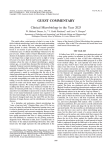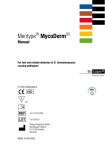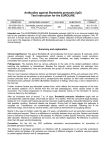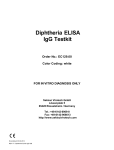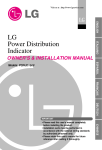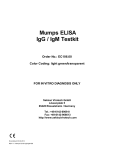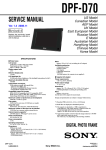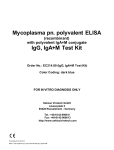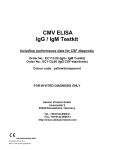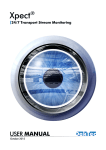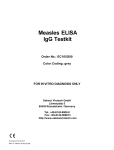Download Package Insert - Sekisui Diagnostics
Transcript
Pertussis Toxin ELISA IgG Testkit / IgA Testkit Order No.: EC215G00 (IgG Testkit) EN215Q60 (IgG Quantification Set) EC215A00 (IgA Testkit) Color Coding: IgG: silver/dark blue IgA: silver/black FOR IN VITRO DIAGNOSIS ONLY Sekisui Virotech GmbH Löwenplatz 5 65428 Rüsselsheim / Germany Tel.: +49-6142-6909-0 Fax: +49-6142-966613 http://www.sekisuivirotech.com Druckdatum 04.02.2014 REV 13 / Pertussis Toxin IgG / Pertussis Toxin IgA ELISA GB Contents 1. Intended Use ......................................................................................................................... 3 2. Diagnostic Relevance ............................................................................................................ 3 3. Test Principle......................................................................................................................... 3 4. Package Contents ................................................................................................................. 3 4.1 4.2 4.3 IgG Testkit....................................................................................................................................................................... 3 IgG Quantification Set ..................................................................................................................................................... 4 IgA Testkit ....................................................................................................................................................................... 4 5. Storage and Shelflife of the Testkit and the ready to use reagents ....................................... 4 6. Precautions and Warnings .................................................................................................... 4 7. Material required but not supplied......................................................................................... 4 8. Test Procedure ...................................................................................................................... 5 8.1 8.2 8.3 8.4 9. Examination Material....................................................................................................................................................... 5 Preparation of Reagents ................................................................................................................................................. 5 Virotech ELISA Test Procedure....................................................................................................................................... 5 Usage of ELISA processors ............................................................................................................................................ 6 Qualitative and semiquantitative test evaluation ................................................................... 6 9.1 9.2 9.3 9.4 9.5 Test function control........................................................................................................................................................ 6 Calculation of the Vir otech Units (VE) ............................................................................................................................. 6 Interpretation Scheme IgG .............................................................................................................................................. 6 Interpretation Scheme IgA............................................................................................................................................... 7 Limits of the Test............................................................................................................................................................. 7 10. Quantitative IgG test evaluation in IU/ml ............................................................................... 8 10.1 Control of test function .................................................................................................................................................... 8 10.2 Calculation of the quantitative results in International Units per ml ( IU/ml) ...................................................................... 8 10.3 Interpretation scheme for IgG.......................................................................................................................................... 9 11. Performance Data .................................................................................................................. 9 11.1 11.2 11.3 11.4 11.5 11.6 11.7 Sensitivity and Specif icity ................................................................................................................................................ 9 Cross Reactiv ity .............................................................................................................................................................. 9 Prevalence (Expectet Values) ....................................................................................................................................... 10 Intra-assay-Coefficient of Variation (Repeatability)........................................................................................................ 10 Inter-assay-Coefficient of Variation (Reproducibility)..................................................................................................... 10 Distribution of the antibody concentrations (in VE) of sera with/without suspected Pertussis........................................ 10 Correlation betw een declared and measured IU/ml....................................................................................................... 10 12. Literature ............................................................................................................................. 11 13. Test Procedure Scheme ...................................................................................................... 12 Seite 2 v on 12 Pertussis Toxin IgG / Pertussis Toxin IgA ELISA GB REV 13 Druckdatum 04.02.2014 1. Intended Use The Pertussis Toxin ELISA is intended for the semiquantitative and qualitative detection of IgG or IgA -antibodies in human serum. It is intended for the detection of an acute or recent infection respectively for the detection of vaccination antibodies (check of vaccination success). It is also possible to quantify the IgG in international units per ml (IU/ml), by using the IgG Quantification Set (EN215Q60), w hich is supplied separately. 2. Diagnostic Relevance The main agent of the genus Bordetella, B. pertussis, causes the clinical picture of w hooping-cough. Milder forms are caused by B. parapertussis, those are not detected w ith the Pertussis Toxin ELISA. The Pertussis Toxin is of significant importance for the pathogenesis of w hooping cough. It is a real exotoxin responsible fo r many physiological, immunological and pharmacological effects. In contrast to other exotoxins of the species Bordetella, that show high cross-reactivities in serum diagnostics, the Pertussis Toxin is high-specific (4). During primary infection, the IgM-antibodies can be detected at the earliest 5-10 days after the beginning of the convulsive stage and persist for 6-12 w eeks; they are the expression of an acute disease. IgA -antibodies can be detected 11 days after disease started at the earliest. IgA antibodies can persist 6-24 months. They are also developed in vaccinated adults during a natural re-infection (w ithout clinical disease) and are therefore found in healthy adults as w ell. Infected infants up to an age of 12 months do usually not develop IgA antibodies against Pertussis Toxin. Infants betw een 1-4 years rarely develop IgA antibodies against Pertussis Toxin, at an age betw een 5-10 years they develop only very small concentrations of IgA antibodies against Pertussis Toxin (6). In this case the detection of specific IgM can be a notice for a recent infection (3). IgG antibodies occur 2-3 w eeks after beginning disease in the serum at the earliest. Re-infections are marked by increased antitoxin-IgG- and -IgA-antibodies as a rule. IgG- and secrete-IgA-antibodies are, beside the specific sensibilised T-lymphocytes, the carrier of the long-term-immunity (2). The pertussis serology cannot replace antigen detection, but should ber performed in addition. The anti-pertussis antibodies are produced later in comparison to other infectious diseases. With the WHO (World Health Organization) International Standard Pertussis Antiserum (NIBSC ( National Institute for Biological Standards and Control) code: 06/140), a reference serum enabling the standardised and precise quantification of the anti-PT IgG concentration of a patient serum in International Units/ml has been in existence since 2009. The Bordetella reference centres in several countries have suggested that this standard serum should be used for a tw o cut-off system, w ith a low er limit of 40/ 50 IU/ml and an upper limit of 100/ 120 IU/ml(11, 12, 13). 3. Test Principle The antibody searched for in the human serum forms an immune complex w ith the antigen coated on the microtiter -plate. Unbound immunoglobulins are removed by w ashing process es. The enzyme conjugate attaches to this complex. Unbound conjugate is again removed by w ashing processes. After adding the substrate solution (TMB), a blue dye is produced by the bound enzyme (peroxidase). The color changes to yellow w hen the stopping solution is added. 4. Package Contents 4.1 IgG Testkit 1. 2. 3. 4. 5. 6. 7. 8. 9. 1 Microtiter-Plate consisting of 96 with antigen coated, breakable single w ells, lyophilised PBS-Dilution Buffer (blue, ready to use) 2x50m l, pH 7,2, w ith preservative and Tw een 20 PBS-Washing Solution (20x concentrated) 50m l, pH 7,2, w ith preservative and Tw een 20 IgG negative Control, 2000µl, human serum w ith protein-stabilizer and preservative, ready to use IgG cut-off Control, 2000µl, human serum w ith protein-stabilizer and preservative, ready to use IgG positive Control, 2000µl, human serum w ith protein-stabilizer and preservative, ready to use IgG-Conjugate (anti-human), 11ml, (sheep or goat)-horseradish-peroxidase-conjugate with protein-stabilizer and preservative in Tris-Buffer, ready to use Tetramethylbenzidine substrate solution (3,3’,5,5’-TMB), 11m l, ready to use Citrate-Stopping Solution, 6m l, contains an acid mixture Seite 3 v on 12 Pertussis Toxin IgG / Pertussis Toxin IgA ELISA GB REV 13 Druckdatum 04.02.2014 4.2 IgG Quantification Set 10. 11. 12. 4.3 IgG calibration control, 2000 µl, human serum w ith protein stabilisers and preservative, ready-to-use IgG w eakly reactive control, 2000 µl, human serum w ith protein stabilisers and preservative, ready -to-use IgG strongly reactive control, 2000 µl, human serum w ith protein stabilisers and preservative, ready -to-use IgA Testkit 1. 2. 3. 4. 5. 6. 7. 8. 9. 5. 1 Microtiter-Plate consisting of 96 with antigen coated, breakable single w ells, lyophilised PBS-Dilution Buffer (blue, ready to use) 2x50m l, pH 7,2, w ith preservative and Tw een 20 PBS-Washing Solution (20x concentrated) 50m l, pH 7,2, w ith preservative and Tw een 20 IgA negative Control, 2000µl, human serum w ith protein-stabilizer and preservative, ready to use IgA cut-off Control, 2000µl, human serum w ith protein-stabilizer and preservative, ready to use IgA positive Control, 2000µl, human serum w ith protein-stabilizer and preservative, ready to use IgA-Conjugate 2 (anti-human), 11m l, (sheep or goat)-horseradish-peroxidase-conjugate with FCS and preservative in Tris-Buffer, ready to use Tetramethylbenzidine substrate solution (3,3’,5,5’-TMB), 11m l, ready to use Citrate-Stopping Solution, 6m l, contains an acid mixture Storage and Shelflife of the Testkit and the ready to use reagents Store the testkit at 2-8°C. The shelf life of all components is show n on each respective label; for the kit shelf life please see Quality Control Certificate. 1. Microtiter strips/single w ells are to be resealed in package after taking out single w ells and stored w ith desiccant at 2-8°C. Reagents should immediately be returned to storage at 2-8°C after usage. 2. The ready to use conjugate and the TMB-substrate solution are sensitive to light and have to be stored in dark. Should there be a color reaction of the substrate dilution due to incidence of light, it is not useable anymore. 3. Take out only the amount of ready to use conjugate or TMB needed for the test insertion. Additional conjugate or TMB taken out may not be returned but must be dismissed. Material Controls Status Diluted Undiluted After Opening Microtitreplate After Opening Rheumatoid factor Absorbent Conjugate Tetramethylbenzidine Stop Solution Undiluted, After Opening Diluted After Opening After Opening After Opening After Opening Final Dilution (ready-to-use) Test Samples Washing Solution 6. Storage +2 to +8°C +2 to +8°C +2 to +8°C +2 to +8° (storage in the provided bag w ith desiccant bag) +2 to +8°C +2 to +8°C +2 to +8°C (protect from light) +2 to +8°C (protect from light) +2 to +8°C +2 to +8°C +2 to +25°C Shelflife max. 6h 1 w eek 3 months 3 months 3 months 1 w eek 3 months 3 months 3 months 3 months 4 w eeks Precautions and Warnings 1. 2. 3. 7. Only sera w hich have been tested and found to be negative for HIV -1 antibodies, HIV-2 antibodies, HCV antibodies and Hepatitis-B surface-antigen are used as control sera. Nevertheless, samples, diluted samples controls, conjugates and microtiter strips should be treated as potentially infectious material. Please handle products in accordance with laboratory directions. Those components that contain preservatives, the Citrate Stopping Solution and the TMB have an irritating effect to skin, eyes and mucous. If body parts are contacted, immediately w ash them under flow ing water and possibly consult a doctor. The disposal of the used materials has to be done according to the country -specific guidelines. Material required but not supplied 1. Aqua dest./demin. Seite 4 v on 12 Pertussis Toxin IgG / Pertussis Toxin IgA ELISA GB REV 13 Druckdatum 04.02.2014 2. 3. 4. 5. 6. 7. 8. 9. 10. 8. Eight-channel pipette 50µl, 100µl Micropipettes: 10µl, 100µl, 1000µl Test tubes Paper tow els or absorbent paper Cover for ELISA-plates Disposal box for infectious material ELISA handw asher or automated EIA plate w ashing device ELISA plate spectrophotometer, w avelength = 450nm, reference length = 620nm (Reference Wavelength 620-690nm) Incubator Test Procedure Working exactly referring to the Sekisui Virotech user manual is the prerequisite for obtaining correct results. 8.1 Examination Material Either serum or plasma can be used as test material, even if only serum is mentioned in the instructions. Any type of anticoagulant can be used for plasma. Alw ays prepare patient-dilution freshly. For a longer storage the sera must be frozen. Repeated defrosting should be avoided. 1. Only fresh non-inactivated sera should be used. 2. Hyperlipaemic, haemolytic, microbially contaminated and turbid sera should not to be used (false positive/negative results). 8.2 Preparation of Reagents The Sekisui Virotech System Diagnostica offers a high degree of flexibility regarding the possibility to use the dilution buffer, w ashing solution, TMB, citrate stopping solution as w ell as the conjugate for all parameters and for all different lots. The ready to use controls are parameter specific and only to use w ith the plate lot indicated in the Quality Control Certificate. 1. Set incubator to 37°C and check proper temperature setting before start of incubation. 2. Bring all reagents to room temperature before opening package of microtiter strips. 3. Shake all liquid components w ell before use. 4. Make up the w ashing solution concentrate to 1 L w ith distilled or demineralised w ater. If crystals have formed in the concentrate, please bring the concentrate to room temperature before use and shake w ell before use. 5. In order to determine the pertussis toxin IgA correctly, it is necessary to pre-treat the sera using RF-SorboTech (VIROTECH adsorption medium). Pre-adsorption is omitted in IgA controls. 8.3 Virotech ELISA Test Procedure 1. 2. 3. 4. 5. 6. 7. 8. 9. 10. For each test batch, pipette 100µl each of the ready-to-use dilution buffer (blank), the controls and the diluted patient sera. We recommend the use of duplicates (blank, controls and patient sera). It is absolutely essential to use duplicates for the cut-off and calibration control. Working dilution of the patient sera: 1+100; e.g. 10µl serum + 1ml dilution buffer. After pipetting start incubation for 30 min. at 37°C (w ith cover). End incubation period by w ashing microtiter strips 4 times w ith 350 – 400µl w ashing solution per w ell. Do not leave any w ashing solution in the w ells. Remove residues on a cellulose pad. Pipette 100µl of ready to use conjugate into each w ell. Incubation of conjugates: 30 min. at 37°C (w ith cover). Stop conjugate incubation by w ashing 4 times (pls. refer to point 3 above). Pipette 100µl of ready to use TMB into each w ell. Incubation of substrate solution: 30 min. at 37°C (w ith cover, keep in dark). Stopping of substrate reaction: pipette 50µl of citrate stopping solution into each w ell. Shake plate carefully and thoroughly until liquid is completely mixed and a homogeneous yellow color is visible. Measure extinction (OD) at 450/620nm (Reference Wavelength 620-690nm). Set your photometer in such a w ay that the blank value is deducted from all other extinctions. Extinctions should be measured w ithin 1 hour after adding the stopping solution! Seite 5 v on 12 Pertussis Toxin IgG / Pertussis Toxin IgA ELISA GB REV 13 Druckdatum 04.02.2014 Pls. refer to last page for Test Procedure Scheme 8.4 Usage of ELISA processors All Sekisui Virotech ELISAs can be used on ELISA processors. The user is bound to proceed a validation of the devic es (processors) on a regular basis. Sekisui Virotech recommends the follow ing procedure: 1. Sekisui Virotech recommends to proceed the validation of device referring to the instructions of the device manufacturer during the implementation of the ELISA processor respectively after bigger reparations. 2. It is recommended to check the ELISA-processor w ith the Validationkit (EC250.00) afterw ards. A regular check using the Validationkit shall be proceeded minimum once a quarter to test the accuracy of the processor. 3. The release criteria of the Quality Control Certificate of the product must be fulfilled for each testrun. With this procedure, your ELISA processor w ill function properly and this w ill support quality assurance in your laboratory. 9. Qualitative and semiquantitative test evaluation The ready to use controls serve for a semiquantitative determination of specific IgG- and IgA-antibodies. Their concentration can be expressed in Virotech units = VE. Fluctuations resulting from the test procedure can be balanced w ith this calculation method and a high reproducibility is achieved in this w ay. Use the means of the OD values for calculation of the VE. 9.1 Test function control a) OD-values The OD of the blank should be < 0.15. The OD-values of the negative controls should be low er than the OD-values mentioned in the Quality Control Certificate. The OD-values of the positive controls as w ell as of the cut-off controls should be above the OD-values mentioned in the Quality Control Certificate. b) Virotech Units (VE) The Virotech Units (VE) of the cut-off controls are defined as 10 VE. The calculated VE of the positive controls should be w ithin the ranges mentioned in the Quality Control Certificate. If those requirements (OD-values, VE) are not fulfilled, the test has to be repeated. 9.2 Calculation of the Virotech Units (VE) The extinction of the blank value (450/620nm) has to be subtracted from all other extinctions. OD (positive control) x 10 OD (cut - off control) OD (patient serum) VE (patient serum) x 10 OD (cut - off control) VE (positive control) 9.3 Interpretation Scheme IgG The Virotech units (VE) of the Pertussis Toxin IgG ELISA (enzyme-linked immunosorbent assay) have been calibrated using the WHO International Standard. This leads to the follow ing calibration betw een Virotech Units (VE) and International Units per ml (IU/ml) for IgG (7). IU/m l (WHO) 36-44 VE IgG- antibodies <9 negative 9 – 11 borderline Seite 6 v on 12 Pertussis Toxin IgG / Pertussis Toxin IgA ELISA GB Interpretation no increased antibody-titer against Pertussis-Toxin: No suspicion of a B. pertussis-infection In case of clinical symptoms a follow up control or a differential diagnosis is recommended. increased antibody-titer against Pertussis-Toxin: Persistent antibodies of a recent infection antibodies of a starting immune response REV 13 Druckdatum 04.02.2014 > 100 > 11 positive > 17 infection vaccination antibodies significant high antibody-titer against Pertussis-Toxin Note tow ards an acute or recent infection Detection of vaccine antibodies: Absolutely consider vaccinemanagement, as the test is not able to differentiate between vaccine antibodies and antibodies of an infection. Significant high antibody-titer against Pertussis-Toxin, an argument for an acute infection if the last vaccination is longer than 12 months ago. 9.4 Interpretation Scheme IgA The Pertussis Toxin IgA ELISA has been adjusted to the WHO International Standard. This gives the correlation in the evaluation betw een Virotech Units (VE) and International Units per Milliliter (IU/ml) for IgA (11, 12). IU/m l (WHO) VE <9 IgA antibodies no increased Ab titre to pertussis toxin: No suspicion of B. pertussis infection If there are clinical symptoms, repeat measurements later or clarify via differential diagnosis. negative < 12 IU/ml > 12 IU/ml Interpretation 9 – 11 borderline > 11 positive increased Ab titre to pertussis toxin: Persisting Ab from a previous infection Ab from the initial stages of an immune response Vaccine antibodies significantly increased Ab titre to pertussis toxin: Accom panied by positive IgG Ab titre (> 11 VE): Evidence for new or recent infection Detection of vaccine antibodies: Essential to consider vaccine management, as the test cannot distinguish betw een vaccine antibodies and infection antibodies. Accom panied by negative or threshold IgG Ab titres (< 11 VE): Repeat measurements later. Notice: IgA-antibodies are not alw ays developed and are therefore a less reliable marker for a Bordetella pertussis infection than IgG-antibodies. 1. 2. 3. 4. 5. 9.5 Absolutely consider vaccine-management, as the test is not able to differentiate betw een vaccine antibodies and antibodies of an infection. If the measured values are above the defined borderline range, they are considered to be positive. If the measured VE is w ithin the borderline range, no significant high antibody concentration is present, the samples are considered to be borderline. For the secure detection of an infection it is necessary to determine the antibody concentration of tw o serum samples. One sample shall be taken directly at the beginning of the infection and a second sample 5 – 10 days later (convalescent serum). The antibody concentration of both samples has to be tested in parallel, that means in one test run. A correct diagnosis based on the evaluation of a single serum sample is not possible. If the measured values are below the defined borderline range, no measurable antigen specific antibodies are present in the samples. The samples are considered to be negative. At a borderline IgA result and the presence of an IgG result <17 VE, a second serum sample is necessary to check for an acute infection. Limits of the Test 1. The interpretation of serological results shall alw ays include the clinical picture, epidemiologic al data and all further available laboratory results. Seite 7 v on 12 Pertussis Toxin IgG / Pertussis Toxin IgA ELISA GB REV 13 Druckdatum 04.02.2014 10. Quantitative IgG test evaluation in IU/ml The ready-to-use calibration control is separately available w ith the IgG Quantification Set (EN215Q60) and is used for the quantitative determination in IU/ml of anti-PT IgG antibodies in patient serum. The calibration control corrects for fluctuations from the test performance. The mean of the OD values is used for the calculation. 10.1 Control of test function a) OD values The OD value of the blank should be <0.15. The OD value of the calibration control must lie w ithin the range given in the corresponding certificate. b) IU/ml The anti-PT IgG concentrations (IU/ml) of the w eakly reactive control and of the strongly reactive control must lie w ithin the ranges given in the quality control certificate. If the requirements are no fulfilled (OD values, IU/ml), the test must be repeated. 10.2 Calculation of the quantitative results in International Units per ml (IU/ml) The extinction of the blank (450/620nm) must be subtracted from all extinctions. Using the Virotech IgG Quantification Set, the patient sera are quantified by correlation w ith the WHO International Standard. Extensive tests have been performed w ith each plate batch. This has led to a standard non-linear regression curve, expressed mathematically by the follow ing formula (14): IU/ml = e (C - Ln ( (D - A) / (OD corr - A) - 1) / B) Where A: B: C: D: OD corr: expected OD w ith an anti-PT IgG concentration of 0 gradient point of inflexion expected OD at an infinitely high anti-PT IgG concentration corrected OD of the patient serum To correct for fluctuations within test processing, the measured OD of the patient serum is corrected w ith a calibration control. OD corr OD Patient serum * OD Calibratio n control given OD Calibratio n control measured The values of parameters A, B, C and D, as w ell as the given value for the OD of the calibration control, are to be found in the certificate. 6 additional standard value pairs are defined in the certificate. These also describe the standard curve and can be used if the evaluation software is not compatible w ith this calculation method. Determ ination of the IU/m l value The IU/ml can be determined w ith a program that can be ordered from Virotech. Alternatively, an evaluation template for common table calculations can be supplied. The borderline range for the quantification w ith the Virotech Pertussis Toxin IgG Quantification Set is defined as being from > 40 IU/ml to < 100 IU/ml, corresponding to the VE range from > 10 VE to < 17 VE. The quantifiable range lies from 5 IU/ml to 500 IU/ml. Seite 8 v on 12 Pertussis Toxin IgG / Pertussis Toxin IgA ELISA GB REV 13 Druckdatum 04.02.2014 10.3 Interpretation scheme for IgG The international units (IU/ml) of the Pertussis Toxin IgG ELISAs w ere calibrated w ith WHO International Standard 335. The interpretation is in accordance w ith the recommendations of European Reference Centres (7, 11, 12, 13, 15). IU/m l (WHO) < 40 > 40 to < 100 > 100 Interpretation No evidence for recent contact with the pathogen Doubtful result. Repeat measurements later or determine IgA-anti-PT: IgA-anti-PT < 11 VE (corresponding to< 12 IU/ml): No evidence for recent pathogen contact IgA-anti-PT > 11 VE (corresponding to> 12 IU/ml): Evidence for recent pathogen contact, assuming that the last vaccination w as more than 12 months previously Pay attention to vaccine management! Evidence for recent pathogen contact, on the assumption that the last vaccination w as more than 12 months previously. Check vaccination management! 11. Performance Data 11.1 Sensitivity and Specificity In an internal study, 151 sera w ith suspected Bordetella pertussis infection w ere tested for anti-PT IgG. These sera have been predefined in Neutralisationtest (NT) by a a former reference centre. The Virotech Bordetella pertussis LINE (Line Immuno Assay), has been used as comparative test. The results are summarised in the follow ing table. Sera Collective (n= 151) Virotech LINE IgG Virotech Pertussis Toxin ELISA IgG negative borderline positive negative 76 1 1 borderline positive 6 2 1 1 7 56 Borderline results have not been considered for the calculation of the sensitiv ity and specificity. Relative to Bordetella pertussis LINE, the sensitivity for IgG w as 96.6 % and the specificity 98.7 %. 11.2 Cross Reactivity In order to test for any cross-reaction between Virotech Pertussis Toxin ELISA and antibodies from respiratory diseases, 37 sera w as tested for IgG and 33 sera w as tested for IgA. The results are show n in the follow ing table: negative IgG 29 IgA 33 borderline 4 0 positive 4 0 The result show s that the Virotech Pertussis Toxin ELISA is a very good tool for the differential diagnostic usage. Seite 9 v on 12 Pertussis Toxin IgG / Pertussis Toxin IgA ELISA GB REV 13 Druckdatum 04.02.2014 11.3 Prevalence (Expectet Values) The follow ing table show s the test results of blood donators for 80 IgG samples and 78 IgA samples. 11.4 IgG IgA negative 73 78 borderline 3 0 positive 4 0 Intra-assay-Coefficient of Variation (Repeatability) In this assay, strips from various plates of a batch w ere tested in a chessboard pattern w ith tw o sera. The coefficients of variation are as follow ed: < 9% for IgG and < 15% for IgA. 11.5 Inter-assay-Coefficient of Variation (Reproducibility) A minimum of 3 sera w ere tested in minimum 10 independent test batches on 3 different test days. This gave a coefficient of variation of ≤ 15%. 11.6 Distribution of the antibody concentrations (in VE) of sera with/without suspected Pertussis 80 blooddonor IgG 80 Blutspender IgG 40,0 40,0 30,0 30,0 20,0 17,0 10,0 100 IU/ml 40 IU/ml 0,0 ∆ in LINE1 predefined positive sera Virotech Units (VE) (VE) Virotech-Einheiten (VE) Virotech-Einheiten Virotech Units (VE) Pertussis-Sera IgG in IgG Pertussis-Seren 20,0 17,0 100 IU/ml The main part of the negative Pertussis-Sera in IgG is found below the 10VE-limit, the main part of the positive ones above the 17VE-limit. In the area between 10 and 17 VE, positive sera are found, whose antibodies may result from post or just starting infection. Significant high antibody-titer responsible for an acute infection, if the vaccination is longer than 12 months ago, are found above 17 VE. The main part of the negative sera of blooddonors is found below the 10 VE-limit. 40 IU/ml 10,0 0,0 ▲ blooddonors in LINE1 predefined negative sera 1 11.7 Line-Immuno-Assay of Virotech Correlation between declared and measured IU/ml The follow ing diagram show s the correlation of the declared IU/ml of several dilutions of the WHO International Standard w ith the IU/ml determined using the Virotech Pertussis Toxin IgG ELISA. The calculated Pearson correlation coefficient demonstrates the very good agreement betw een the calculated and declared values. Seite 10 v on 12 Pertussis Toxin IgG / Pertussis Toxin IgA ELISA GB REV 13 Druckdatum 04.02.2014 Pearson correlation coefficient = 0,998 12. Literature 1. 2. 3. 4. 5. 6. 7. 8. 9. 10. 11. 12. 13. 14. 15. Medizinische Mikrobiologie Hahn, Falke, Klein, Springerverlag 1991, p361 - 363 Wiersbitzky, Pertussis Kostengünstige Prävention zuw enig genutzt, 1995, Therapiewoche 25, p1485-1486 Lehrbuch der Medizinischen Mikrobiologie, Brandis, Köhler, Eggers, Pulverer, 7. Auflage, p483 Mastrantonio et al., Bordetella parapertussis infections, 1997, Dev Biol Stand, 89, p255-259 Mastrantonio et al., Antibody kinetics and long-term sero-prevalence in the Italian clinical trial of acellular pertussis vaccines, 1997, Dev Biol Stand, 89, p275-278 Wirsing von König et al., Evaluation of a single-Sample Serological Technique for Diagnosing Pertussis in Unvaccinated Children, 1999, Eur J Clin Microbiol Infect Dis, 18, p341-345 De Melker et al., Specificity and sensitivity of high levels of immunoglobulin G against pertussis toxin in a single serum sample for diagnosis of infection w ith Bordetella pertussis, 2000, J Clin Microbiol, 38, p800-806 Sw idsinski, Diagnostische Bibliothek, Nr. 47, April 1997 Meade et al., Serodiagnosis of Pertussis, 1994, Center for Biologics and Research, Food and Drug Administration, Bethesda, Maryland 20892. Meijer, Numerical Comparison of 4 Pertussis Toxin IgG-ELISAs, 2002, nicht publiziert, Krankenhaus Groningen, NL Riffelmann et al., Performance of Commercial Enzyme-Linked Immunosorbent Assays for Detection of Antibodies to Bordetella pertussis, 2010, J Clin Microbiol, 48, p4459-4463 Guiso et al., What to do and w hat not to do in serological diagnosis of pertussis: recommendations from EU reference laboratories, 2010, Eur J Clin Microbiol Infect Dis, DOI 10.1007/s10096-010-1104-y RKI Ratgeber Infektionskrankheiten - Merkblätter für Ärzte: Pertussis (Keuchhusten), 03.09.2010 Plikaytis et al., Comparisons of Standard Curve-Fitting Methods To Quantitate Neisseria meningitidis Group A Polysaccharide Antibody Levels by Enzyme-Linked Immunosorbent Assay, 1991, J Clin Microbiol, 29, p1439-1446 Podbielski et al., MiQ 13/2010, Mikrobiologisch-infektiologische Qualitätsstandards (MiQ), Teil II (Heft 13b), Bakterielle Erreger: Bordetella pertussis, 2. Auflage, p98-106 Seite 11 v on 12 Pertussis Toxin IgG / Pertussis Toxin IgA ELISA GB REV 13 Druckdatum 04.02.2014 13. Test Procedure Scheme Preparation of Patient Samples and Washing Solution ▼ Washing Solution: Fill up concentrate to 1 liter with aqua dest./demin. IgG-Samples – Dilution 1:101 IgA-Samples – Dilution 1:100 e.g.: 10 µl serum/plasma + 1000 µl Dilution Buffer (Serum Dilution Buffer is ready to use) e.g.: 5 µl serum/plasma + 450 µl Dilution Buffer + 1 drop RF-SorboTech, incubate for 15 min. at room temperature. Testprocedure Samples Incubation 30 minutes at 37°C 100 µl Patient Samples blank value (Dilution Buffer) and controls 400 µl Washing Solution Wash 4times Remove Residues on a Cellulose Pad Conjugate Incubation 30 minutes at 37°C 100 µl Conjugate IgG, IgA 400 µl Washing Solution Wash 4times Remove Residues on a Cellulose Pad Substrate Incubation 30 minutes at 37°C Stopping 100 µl Substrate 50 µl Stopping Solution shake carefully Measure Extinctions Seite 12 v on 12 Pertussis Toxin IgG / Pertussis Toxin IgA ELISA GB Photometer at 450/620nm (Reference Wavelength 620690nm) REV 13 Druckdatum 04.02.2014












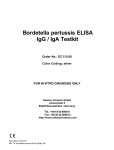
![[第1版][第2版][第3版]](http://vs1.manualzilla.com/store/data/006595470_3-dbe64e74ccb5b6ddca2b99bd6e407bf4-150x150.png)


